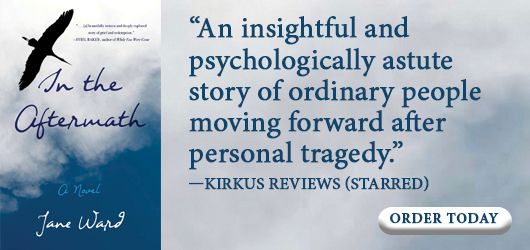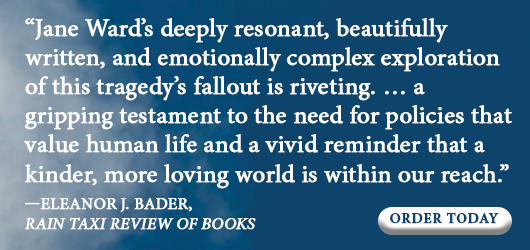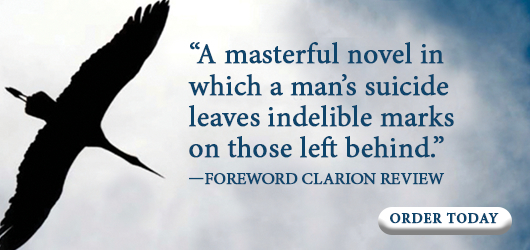A vivid reminder that a kinder, more loving world is within our reach
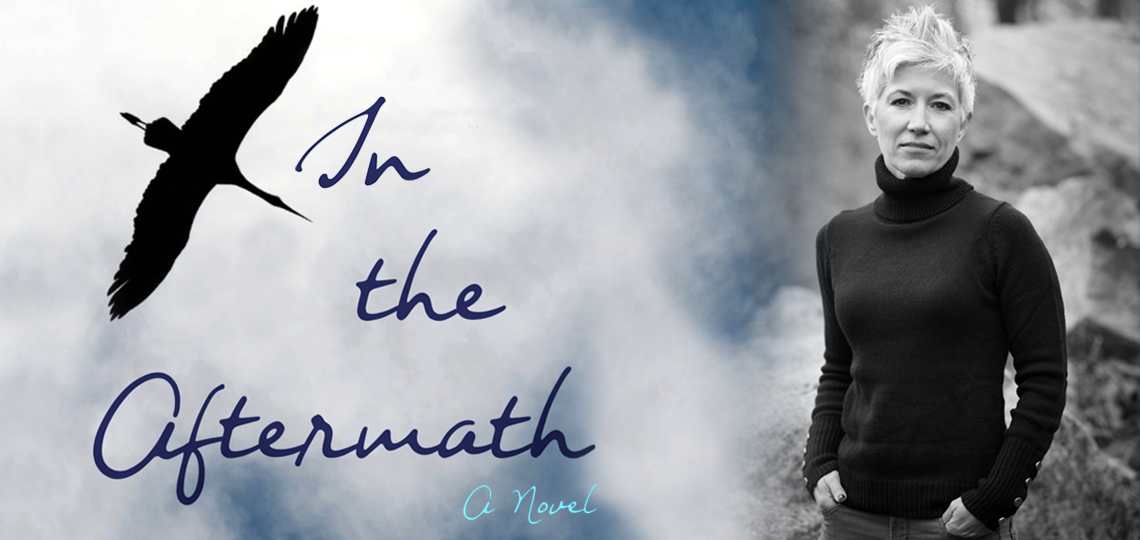
Life happens—in fits and starts, through miracles and madness. No one gets out of here without facing all manner of life-changing events, both good and bad. But what you do next—get back up after a personal crisis or get broken down—makes for the most compelling human story of all.
Today, we’re excited to introduce Jane Ward, author of In the Aftermath, a wonderful novel about the repercussions of a suicide. With our eye on better understanding how an author creates believable characters while crafting a riveting story, we asked Matt Sutherland to catch up with Jane for the following conversation.
Widows and divorcees. Single mothers, wanderlust sons, and fatherless daughters. Professional bakers and criminal investigators. Commercial loan officers and birders. Your writing chops are generously supported by insider knowledge of many diverse skills, circumstances, and interests. So, how did this particular story get written by this particular writer, Jane Ward?
My husband calls me relentlessly curious, and I am, about almost everything. I especially like to observe and talk to people to find out about their lives and occupations. This curiosity carries over to the natural world as well. Birds were a big part of my life between 2015 and 2018 while I was writing In the Aftermath. I would take frequent dog walks to have breaks from the heavy scenes I was in the middle of and found myself paying more and more attention to the peace and quiet of the water birds when we were out at a nearby lake. I’d go home to look them up in bird guides so I knew what I was seeing. It’s no surprise birds feature so much in the book.
When I don’t know something well, I’ll research. I did a lot of reading, for example, of newspapers and book excerpts that related to the economic downturn beginning in 2007–2008 to get a sense of what it was like to be in the housing loan and banking industries. Of all the characterizations and jobs you list, I have firsthand experience of only one, and that is professional baker. I baked for a smallish neighborhood bakery for a couple of years and thought a family-owned bakery would make an ideal backdrop for a story beginning with a small business struggling to survive. Small food business owners are often more passionate about doing something well than they are cutting corners, and a bakery is one of those places that rely on everyone doing well to stay in business. If the economy is uncertain, belts get tightened and there’s no more indulging in expensive boxes of hand-crafted pastry on the weekends. That I knew that world made it natural for me to set the book there.
The devastating, snowballing effects of a failing small business cause an aftermath of their own. And, in a sense, all-consuming entrepreneurialism—accompanied by onerous debt—is a great American story, sadly. Do some of the grand themes in the book find their origins in the books you’ve loved over your reading life?
I’ve been reading since age four, and that early obsession with books led to majoring in English Literature in college. There, I concentrated first on the works of Victorian-era British writers who were writing about child labor and class divides and the clash between the oppressed and the wealthy, and then later, late 19th/early 20th century American writers who tackled issues such as wealth and reckless disregard, women’s issues, race and racism.
Influence is a curious thing. Some books I liked; others I didn’t; but all of them left their stamp on me. My favorites were the American stories set against a backdrop of social struggle which then zoomed in to tell a personal story of an individual or family. Absalom, Absalom; The Bluest Eye; Invisible Man; The Awakening–all favorites to this day. I am drawn to these kinds of tales because struggle and conflict so often reveal what it means to be human.
All of your characters are marked by David’s suicide, and each of them, in their own ways, hold themselves responsible—as if they could have done more to prevent it. And the guilt is omnipresent for years after David’s death. Do you care to talk about suicide as a topic, and whether this book served as a way for you to, perhaps, work through something?
I did not start out to write about the aftermath of a suicide. I didn’t want to—it was terrifying to think I’d have to live with all that despair for however many years it took to finish the book. When I began work, I knew David wanted an escape from his overwhelming financial burdens. Initially, I thought he might just run away from them. The story, after all, was about the people left behind to face his absence and the problems he created. So, I drafted his leaving and pretty quickly realized it just wasn’t working. David was so despondent that I couldn’t see him starting a new life elsewhere without a care in the world. I had to face what I feared writing about.
As so often happens, once I started talking about my project with people, an individual would pull me aside and say, “Well, you know, I have experience with this.” It’s something that is so rarely discussed openly because there is a lot of guilt and shame and judgment associated with the act. People who take their lives are often declared “weak” and “selfish” by outsiders. Their loved ones feel unspoken accusations such as “Why didn’t you see it coming and do something?” Once I dove in, it was my hope that maybe this story might shine a light on how damaging it is to keep secrets and try to appear strong when we’re not, and also that talking in the aftermath of suicide is far better than bottling up the pain.
An ex-investigator for the cops, you introduce Denise while she struggles through a therapy session. As it turns out, she has serious regrets at the memory of her ruthless interrogation of David’s wife, Jules, and daughter, Rennie, after David’s suicide. And Charlie, David’s best friend, entered therapy as a means to deal with the death. Please talk about the client-therapist dynamic and why you chose it as one angle among many to tell this story?
Denise had been on her own journey of bottled-up frustrations and anger and guilt and had found her way to a therapist—something she sensed might help her start to forgive herself for the dismissive way she investigated David’s suicide. You’re right when you say she struggled through her sessions. So much so that at one point she declared herself “all better” and left therapy. But she goes back! She understands she owes it to herself and her sons to feel as well as possible.
Charlie takes more time to realize he needs help but when he does, he goes all in. I felt that the action of talking about their emotions let some air—and hope—into their lives, lives that had been stunted in the wake of the suicide. As I mentioned earlier, there is great relief after breaking down the stoic walls and finally talking. I felt the physical weights lifting as I was writing their final scenes with their respective therapists.
In an emotional scene near the end of the book, Charlie and Jules are discussing Rennie’s idea for scattering David’s ashes. And Charlie is initially taken aback by the news. “But as he sat with Rennie’s idea of a good-bye,” you write, “it began to grow on him. Over the past few years, David’s absence had taken up as much space as his living presence. He had remained with them in the way humans live with heavy cement stanchions or brick walls. Stumbling blocks. Barriers. What would it be like if David as impediment disappeared with a proper good-bye and the landscape opened? Charlie’s eyes teared up.”
The word “closure” may be tiresome to the ear, but it certainly seems as if everyone touched by David’s death is seeking just that sort of relief from their conflictions. Is there such a thing as closure? Does it stick around for long, in your estimation, or does it morph into something else related to the episode?
I’m not sure that anyone achieves closure so much as they reach an ease with a moment and with themselves. The characters in the book have all confronted something so unexpected and devastating and it shook them and their beliefs to their underpinnings and in what the future would look like. Perhaps what we must be content with in any given moment is not that things have come to a close and all will be well, but that we can learn to be prepared and stronger to face whatever comes in the future—to know we’ll have to see the way through whatever comes.
Jules says it best when she thinks to herself that the “entire world had shifted and would continue shifting, in ways no one could anticipate.” I often let my imagination wander to the lives of characters I’ve written to check in on them and their futures. I see good days and not so good days for this group, not a straight line. But I also see resilience in the face of struggle.
David’s parents, Miriam and Paul, remain hard to like throughout the book—a decision you made consciously, no doubt. Please talk about how you achieve such a fictional feat, and the purpose those two served in the book?
They are hard to like, aren’t they? From the start, we learn that Miriam looks down her nose at Jules and Paul is awfully hard on his son, David. Both are very controlling. Their love for their granddaughter, Rennie, saves them, I think, from being stereotypical and truly unlikeable. That love is real, and it helps them express their love for their son in an albeit indirect way. I think of the scene where Miriam passes down a family treasure to Rennie and Rennie recognizes the kindness behind her grandmother’s brusqueness. As for Paul, he is motivated to do what he thinks is best for David and Rennie. In both instances, he makes what we can see are two awful choices, but he believes he is right. That certainty is a very human trait too, his unwillingness to admit to being wrong a weakness that I hope we can all relate to. It was always my hope that Paul’s actions might help us understand not just ourselves but also who David became and why.
Can you divulge what you’re working on now? Another novel, perhaps?
I am in the first draft stage of my fourth novel, working title Mothering. The main character is an older, adoptive mother, a woman who (we learn as the story opens) gave up the biological child she had when she was a young college student. The memories of giving up her son have been suppressed while she has built a career, but recent events bring it to the forefront of her mind until she can’t let it go. In these early stages, I’m never quite sure where the characters will take me. Big picture, though, the story is about the different ways one can be a mother, but it’s also about the different kinds of care women provide in all parts of our lives and the kinds of care we women allow ourselves to receive.
IN THE AFTERMATH
She Writes Press (Sep 21, 2021)
Softcover, $16.95 (352 pp)
978-1-64742-193-9
Clarion Rating: 4 out of 5
In the Aftermath is a masterful novel in which a man’s suicide leaves indelible marks on those he left behind.
In Jane Ward’s novel In the Aftermath, a man’s decision to take his own life has far-reaching effects on others.
Unbeknownst to his wife, Jules, David has driven his family so deep in debt that he is afraid they will lose their bakery business. Believing he has failed his family, and that no one will ever trust or respect him again, David commits suicide. His decision impacts many people in separate, somewhat connected ways.
Five people in particular—Jules; the couple’s daughter, Rennie; David’s best friend, Charlie; Denise, the detective who investigates the case; and Daniel, the lending specialist who works at the bank where David secured loans—are seen struggling with an array of emotions, including disbelief, guilt, and anger. Their disparate ways of coping are seen to suit their individual personalities and needs.
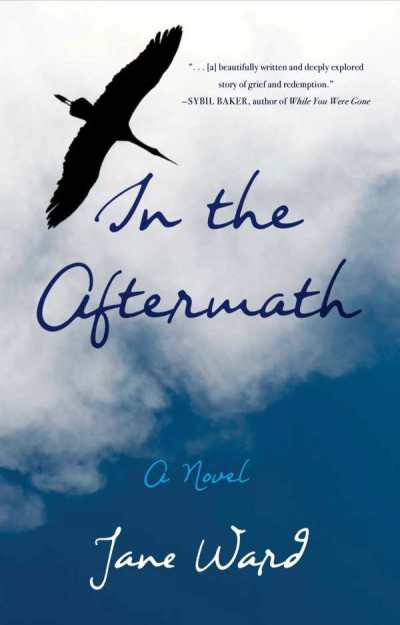
The early portions of the novel are given over to backstory; as such, they are light on drama. But once the characters have been introduced, the rest of the book reads as focused and intentional. Themes related to David’s suicide, and its consequences on the lives of others, are handled in a logical, sequential manner. The characters are well constructed, and the setting is established ably, with the help of sound writing.
Indeed, the book’s descriptions are painstaking in their detail, down to the baking processes of items in Jules and David’s shop. Still, not all of this meticulous accounting moves the story forward: Denise’s early arrival at her son’s school for pick up, a trip during which she spots Rennie, is delayed by multiple paragraphs relaying what she could have been doing at home instead.
Still, despite the volume of the book’s exposition, its lengthy descriptions are kept somewhat to a minimum. For most of the book, the attention is on David’s suicide, and its rippling effect on others; this central theme is surveyed via multiple points of view. Momentum builds and is released as the book moves between the members of its cast. While this means that each person is developed in a limited number of pages, each person’s story nonetheless proves to be deep—and essential to understanding the makeup of the whole story.
In the Aftermath is a masterful novel in which a man’s suicide leaves indelible marks on those left behind.
Reviewed by Florence Osmund August 17, 2021
Matt Sutherland

